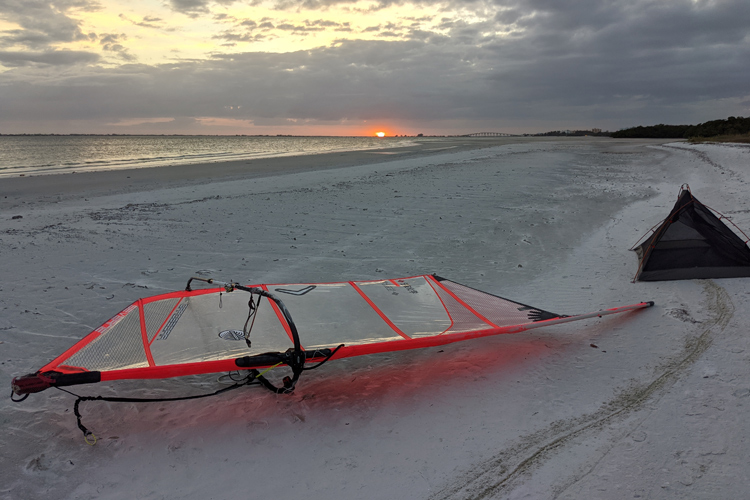Anthony Vandenberg, also known as "Bermuda Boy," has once again windsurfed through rough times at the 2020 WaterTribe Everglades Challenge.
This year, the 300-nautical mile sailing competition was marked by the tragic death of Jim Slauson, a 73-year-old sailor from St. Petersburg, Florida.
The Everglades Challenge is an unsupported, expedition-style competition for small sailboats, canoes, and kayaks.
Participants must carry their water and food, emergency position-indicating radio beacons, and GPS tracking devices.
No support crews or safety boats are allowed. The time limit to complete the adventure from Tampa Bay to Key Largo is eight days.
Here's Vandenberg's diary.
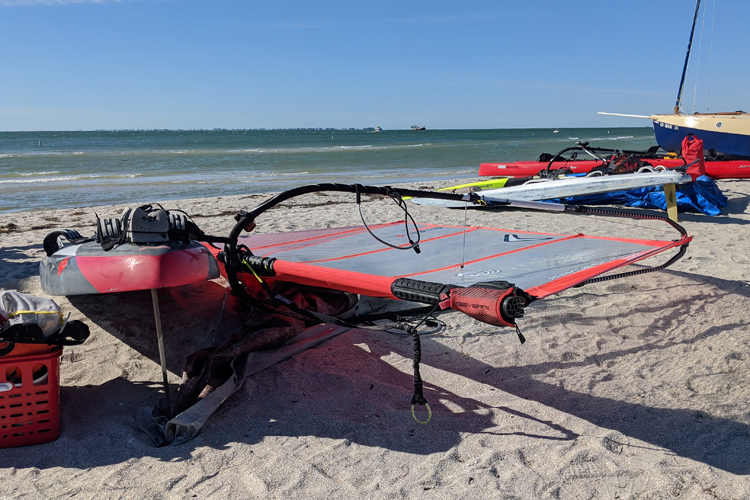
Saturday, March 7, 2020 | Day One
The winds are blowing at 20 knots with gusts into 30, and giant rollers in Tampa Channel formed as the NE wind blew against the incoming tide.
Needless to say, wind conditions are brutal. The race start was put on Plan B at 10 am after waiting on hold for a start.
We chose to kick off from the south of Tampa Bay's main channel at Sean Hawes' home of Sarasota Bay from Lito Key.
The race was set to start at 7 am, but with the change of venue and a move to the south, we didn't end up starting till about 2 pm.
We sailed out of Sarasota Big Pass into the Gulf and hugged the coast of Florida in range just far enough offshore to get clean air - not fouled by the hotels and condos - but not too far out to get into the offshore nuclear wind.
We made it to the Stump Pass and camped for the night on a natural shoreline of what turned out to be a Beach State Park.
We even found a picnic table waiting just for us, up in the mangrove tree line - an awesome camp.
I'm too tired to blow up my air mattress.
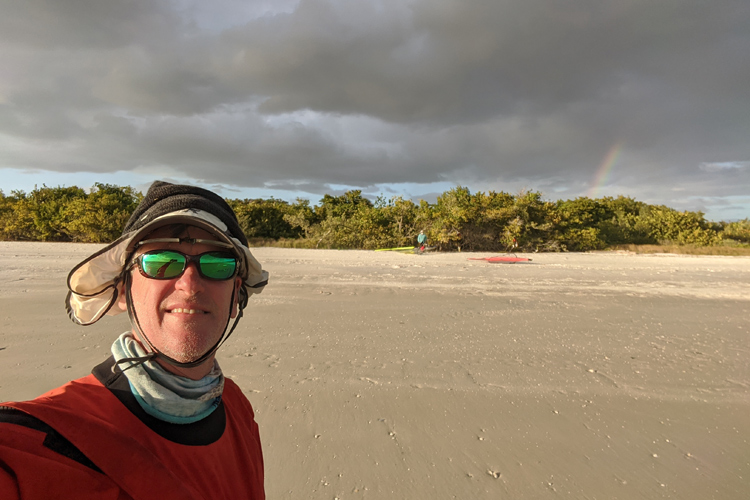
Sunday, March 8, 2020 | Day Two
We woke up and sailed on the Gulf side again until wind conditions powered up to the point we didn't want to wet the inside of our drysuits.
So, we cut into Gasparilla Pass and got into in Port Charlotte Bay and Pine Island Sound.
Gasparilla Pass had only four inches of water over the sand for 1,000 miles, so we had to walk our boards to deep enough water before getting under the bridge.
Sean's sail began ripping badly at the top.
Once inside Port Charlotte/Pine Island Sound, we had some super-fast, long, broad reaches and giant waves from large motorboats aircraft carrier size and one with more Yamahas 300s on the stern than I could count, going almost as fast as us.
We were about four miles to the East of North Captiva Island when we got hit by a massive squall line that knocked us down.
We laid down low on our boards with a safety line between us, joking about the giant hammerhead sharks that roam these waters, as we ended up getting blown back to the beautiful beach on Captiva, landing about 3 pm.
The wind was howling without letting up, so we ended up wasting the day moping around the beach and walking out to the point, waiting for the wind to calm down some.
Finally, we just gave up and set up camp for the night.
Another awesome and beautiful camp, a roaring fire, and instead of my air mattress, I gathered up bales of dried seaweed and made a comfortable mattress under my tent.
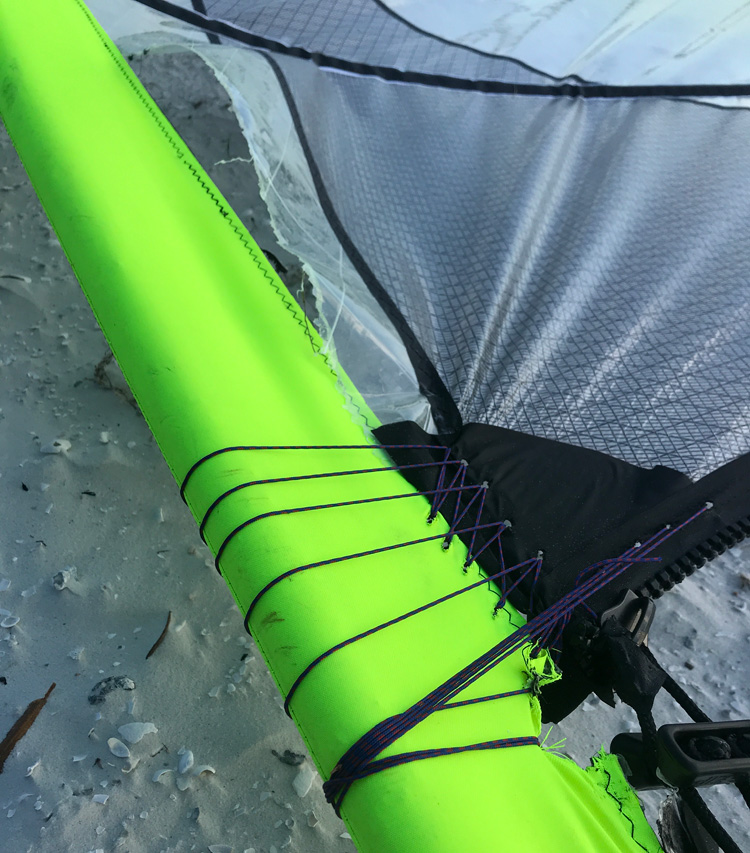
Monday, March 9, 2020 | Day Three
Morning came, and Sean's sail ripped even more when he was fine-tuning the downhaul, so we used nylon line to sew/lash and patch it up the best we could and continue.
I tried re-taping my ripped sail, but shortly thereafter, the tape just peeled off. It stopped ripping about two feet in from the luff.
We sailed beating upwind in some of the hardest conditions I have ever sailed in, especially around the southeastern tip of Sanibel Island, and then all wind hell broke loose, but we somehow made it through to the base of Sanibel Causeway.
We stopped there and waited for the wind to die down for about a few hours.
A father/daughter team of WaterTribers arrived in a Hobie TI, stopping so the daughter could return to school.
They presented us with a bounty of all their snacks. Wow! Are we lucky, or what?
When the wind came down to about 10-12 knots, we launched on a heading across about a five-mile cut of open water aiming for Fort Meyers.
We were about a half-mile from reaching the other side when we saw another more intense monster black squall line ripping our way.
It hit with such intensity, in the upper 20s with gusts well above 30, that we both were so scared whether we could hold it down and prevent getting knocked down.
I was terrified because a fall in those conditions would be unrecoverable, and while we wouldn't be blown out to sea, we would be blown backward back to the close to the morning's start.
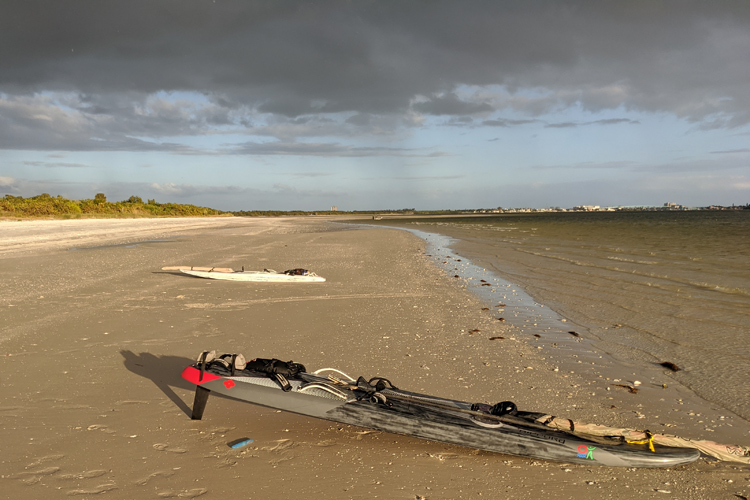
Just as I was making it into the shallows of the "safe side," Sean disappeared out of my bouncing/swirling on the dashboard doggie head field of view.
I feared that he had gone down and started panicking about what I should do.
Call the Coast Guard? Wait for the squall to blow itself out? Head back and search?
While I was panicking, a split second later, I was never more relieved to see that he had made it by bearing off and landing about 100 yards downwind from my landing.
We joined back up, decided enough was enough, and set up camp for the evening.
As on almost every night, Sean gathered firewood and made a great fire.
That night, he had found a washed-away dock full of ants, which he violently evicted, and then made it to our staging table for dinner and organizing our gear.
I tried some trolling on the board while paddling in some nasty, gusting wind, but the fish seemed to have been scared away by the ferocious squall.
I decided that this time, the beach sand was so smooth and fine. I wouldn't blow up my air mattress.
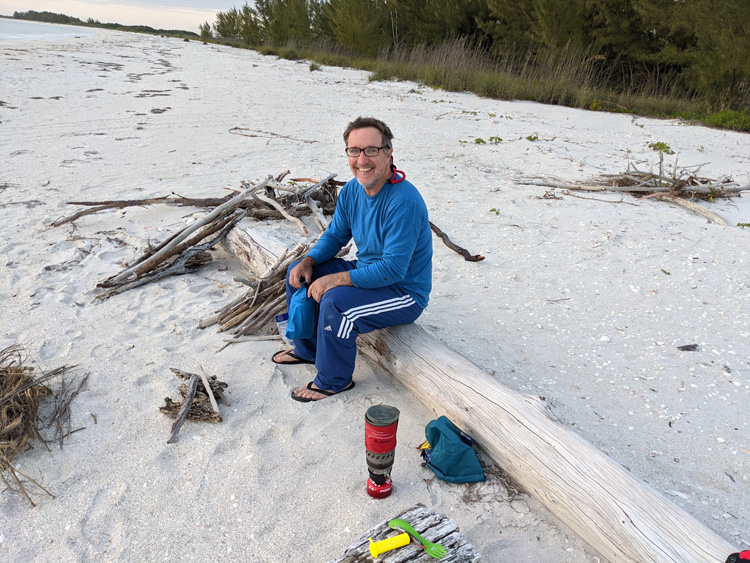
Tuesday, March 10, 2020 | Day Four
It was our best day of sailing.
We hugged the coast for the same reasons, from Fort Meyers all the way around Marco Island, and made it to Caxambas Pass.
Then, the wind totally died out, and we stopped for the night.
All day, the sail was looking ahead, seeing the gust approach, catching it and getting up on broad reach plane, and then riding it and the rollers till it weakened, then repeat over and over and over.
Nothing scary - just excellent mileage sailing from sun up to almost sundown.
Prizes for that day?
I caught a fish trolling near our campsite, bummed a beer off of some beachgoers in Naples, saw two sharks, found a neat place where we cross an island, and waded through a canal to fill up our water bladders.
We made camp about a mile south of Caxambas Pass, at Dickman's Pass, beside a couple of campers that had set up their camp right at the mouth of Dickman's Pass.
Not too long after landing, the camper husband was shouting about having a big shark on his line.
We dropped in the middle of setting up our camping gear and watched him fight it for a while as his line squealed as it sped off the reel, and it suddenly snapped, and the show was over.
Later, as I gave Sean a lesson on all the starry constellations brightly visible to us that evening, I decided I would man up and blow up my air mattress tonight.
Wednesday, March 11, 2020 | Day Five
In the last three days, we decided against going into either Caxambas or Dickman's Pass. We chose to sail in the light morning breeze south and down around Big Marco Pass Shoal.
As we made it around the tip of the shoal, the wind filled in nicely, and we close-hauled (or at least I did) all the way up and across 12 nautical miles of Gullivan Bay and into the Everglades, taking a short break at entrance island, Indian Key.
We then continued with erratic wind up the twisty six-nautical-mile long mangrove channel, before entering Chokosolokee Bay and reaching thigh-deep 100 yards of mud and making it to hard shore.
In the mangroves channel, I had thought I got some good video of a strange colored raccoon, and Sean and I saw what unbelievably looked like a 100-pound nurse shark, jumping five feet out of water.
After having two pounds of fresh peeled shrimp, a blackened grouper sandwich, and four Coronas - the tasty type - at the Pink Cuban restaurant, the only restaurant in Chokosolokee, Sean informed he had reached his limit and didn't see any point in proceeding to Flamingo Check Point 3.
The forecast had very strong sustained easterly wind - totally offshore - for the coming days.
While we could hug the Everglades Cost to Cape Sable relatively safely, getting from there eastward to Flamingo and across Florida Bay to the Key Largo finish would be practically impossible.
Perhaps downright dangerous if anything ripped, snapped or broke further.
I considered continuing on alone, but frankly, I was quite terrified of proceeding on my own with the wind direction that would flush me out into the Gulf of Mexico if things went bad on my equipment or body or more likely getting knocked down by another strong squall blast.
I decided to call and consult with my beautiful life manager, Masami.
She sealed the deal for me - actually made it much easier for me that she did! - when she said: “absolutely not. Come home!"
Sean was right. It was the best and most prudent decision.
Sorry to disappoint yet again, but we decided to withdraw from the race after just reaching/entering the Everglades at Chokosolokee.
It was pretty much the same as what we did in the 2016 Challenge with just about 200 miles sailed.
PS: A special mention to our fellow WaterTriber, Jim Slauson "SailorMan", who was lost at sea doing what he loved best. On Tuesday, the Coast Guard found his boat floating upside down about 40 miles offshore.
Our prayers for his family and trusting he is in Heaven where the winds are always blowing on his favorite tack.
Words by Anthony Vandenberg | Windsurfer
